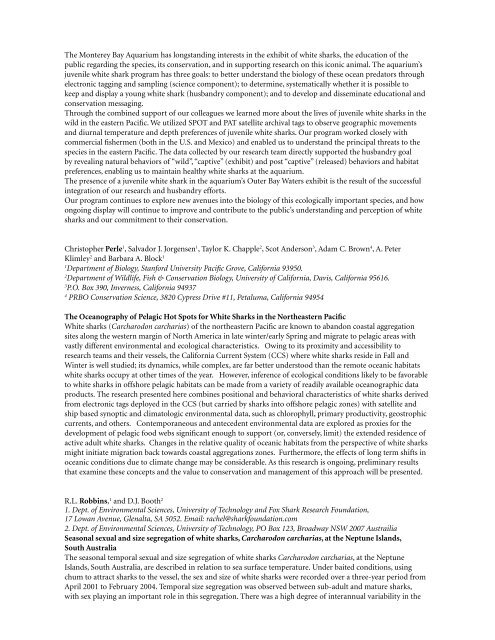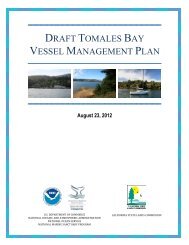Symposium program - Gulf of the Farallones National Marine ...
Symposium program - Gulf of the Farallones National Marine ...
Symposium program - Gulf of the Farallones National Marine ...
Create successful ePaper yourself
Turn your PDF publications into a flip-book with our unique Google optimized e-Paper software.
The Monterey Bay Aquarium has longstanding interests in <strong>the</strong> exhibit <strong>of</strong> white sharks, <strong>the</strong> education <strong>of</strong> <strong>the</strong><br />
public regarding <strong>the</strong> species, its conservation, and in supporting research on this iconic animal. The aquarium’s<br />
juvenile white shark <strong>program</strong> has three goals: to better understand <strong>the</strong> biology <strong>of</strong> <strong>the</strong>se ocean predators through<br />
electronic tagging and sampling (science component); to determine, systematically whe<strong>the</strong>r it is possible to<br />
keep and display a young white shark (husbandry component); and to develop and disseminate educational and<br />
conservation messaging.<br />
Through <strong>the</strong> combined support <strong>of</strong> our colleagues we learned more about <strong>the</strong> lives <strong>of</strong> juvenile white sharks in <strong>the</strong><br />
wild in <strong>the</strong> eastern Pacific. We utilized SPOT and PAT satellite archival tags to observe geographic movements<br />
and diurnal temperature and depth preferences <strong>of</strong> juvenile white sharks. Our <strong>program</strong> worked closely with<br />
commercial fishermen (both in <strong>the</strong> U.S. and Mexico) and enabled us to understand <strong>the</strong> principal threats to <strong>the</strong><br />
species in <strong>the</strong> eastern Pacific. The data collected by our research team directly supported <strong>the</strong> husbandry goal<br />
by revealing natural behaviors <strong>of</strong> “wild”, “captive” (exhibit) and post “captive” (released) behaviors and habitat<br />
preferences, enabling us to maintain healthy white sharks at <strong>the</strong> aquarium.<br />
The presence <strong>of</strong> a juvenile white shark in <strong>the</strong> aquarium’s Outer Bay Waters exhibit is <strong>the</strong> result <strong>of</strong> <strong>the</strong> successful<br />
integration <strong>of</strong> our research and husbandry efforts.<br />
Our <strong>program</strong> continues to explore new avenues into <strong>the</strong> biology <strong>of</strong> this ecologically important species, and how<br />
ongoing display will continue to improve and contribute to <strong>the</strong> public’s understanding and perception <strong>of</strong> white<br />
sharks and our commitment to <strong>the</strong>ir conservation.<br />
Christopher Perle 1 , Salvador J. Jorgensen 1 , Taylor K. Chapple 2 , Scot Anderson 3 , Adam C. Brown 4 , A. Peter<br />
Klimley 2 and Barbara A. Block 1<br />
1<br />
Department <strong>of</strong> Biology, Stanford University Pacific Grove, California 93950.<br />
2<br />
Department <strong>of</strong> Wildlife, Fish & Conservation Biology, University <strong>of</strong> California, Davis, California 95616.<br />
3<br />
P.O. Box 390, Inverness, California 94937<br />
4<br />
PRBO Conservation Science, 3820 Cypress Drive #11, Petaluma, California 94954<br />
The Oceanography <strong>of</strong> Pelagic Hot Spots for White Sharks in <strong>the</strong> Nor<strong>the</strong>astern Pacific<br />
White sharks (Carcharodon carcharias) <strong>of</strong> <strong>the</strong> nor<strong>the</strong>astern Pacific are known to abandon coastal aggregation<br />
sites along <strong>the</strong> western margin <strong>of</strong> North America in late winter/early Spring and migrate to pelagic areas with<br />
vastly different environmental and ecological characteristics. Owing to its proximity and accessibility to<br />
research teams and <strong>the</strong>ir vessels, <strong>the</strong> California Current System (CCS) where white sharks reside in Fall and<br />
Winter is well studied; its dynamics, while complex, are far better understood than <strong>the</strong> remote oceanic habitats<br />
white sharks occupy at o<strong>the</strong>r times <strong>of</strong> <strong>the</strong> year. However, inference <strong>of</strong> ecological conditions likely to be favorable<br />
to white sharks in <strong>of</strong>fshore pelagic habitats can be made from a variety <strong>of</strong> readily available oceanographic data<br />
products. The research presented here combines positional and behavioral characteristics <strong>of</strong> white sharks derived<br />
from electronic tags deployed in <strong>the</strong> CCS (but carried by sharks into <strong>of</strong>fshore pelagic zones) with satellite and<br />
ship based synoptic and climatologic environmental data, such as chlorophyll, primary productivity, geostrophic<br />
currents, and o<strong>the</strong>rs. Contemporaneous and antecedent environmental data are explored as proxies for <strong>the</strong><br />
development <strong>of</strong> pelagic food webs significant enough to support (or, conversely, limit) <strong>the</strong> extended residence <strong>of</strong><br />
active adult white sharks. Changes in <strong>the</strong> relative quality <strong>of</strong> oceanic habitats from <strong>the</strong> perspective <strong>of</strong> white sharks<br />
might initiate migration back towards coastal aggregations zones. Fur<strong>the</strong>rmore, <strong>the</strong> effects <strong>of</strong> long term shifts in<br />
oceanic conditions due to climate change may be considerable. As this research is ongoing, preliminary results<br />
that examine <strong>the</strong>se concepts and <strong>the</strong> value to conservation and management <strong>of</strong> this approach will be presented.<br />
R.L. Robbins, 1 and D.J. Booth 2<br />
1. Dept. <strong>of</strong> Environmental Sciences, University <strong>of</strong> Technology and Fox Shark Research Foundation,<br />
17 Lowan Avenue, Glenalta, SA 5052. Email: rachel@sharkfoundation.com<br />
2. Dept. <strong>of</strong> Environmental Sciences, University <strong>of</strong> Technology, PO Box 123, Broadway NSW 2007 Austrailia<br />
Seasonal sexual and size segregation <strong>of</strong> white sharks, Carcharodon carcharias, at <strong>the</strong> Neptune Islands,<br />
South Australia<br />
The seasonal temporal sexual and size segregation <strong>of</strong> white sharks Carcharodon carcharias, at <strong>the</strong> Neptune<br />
Islands, South Australia, are described in relation to sea surface temperature. Under baited conditions, using<br />
chum to attract sharks to <strong>the</strong> vessel, <strong>the</strong> sex and size <strong>of</strong> white sharks were recorded over a three-year period from<br />
April 2001 to February 2004. Temporal size segregation was observed between sub-adult and mature sharks,<br />
with sex playing an important role in this segregation. There was a high degree <strong>of</strong> interannual variability in <strong>the</strong>







